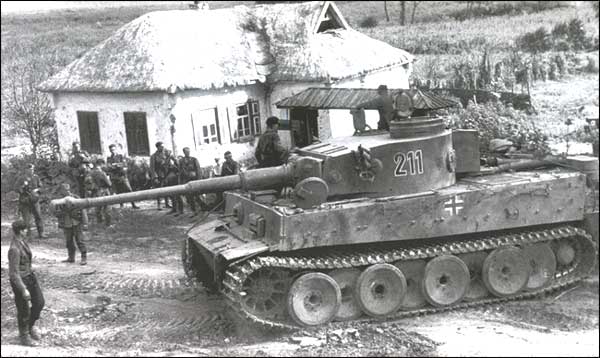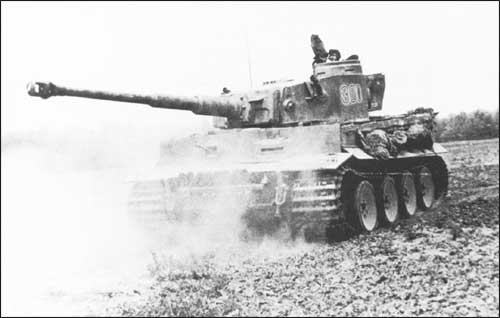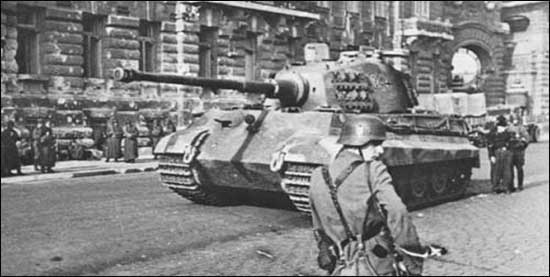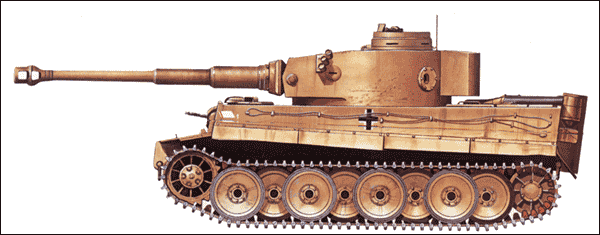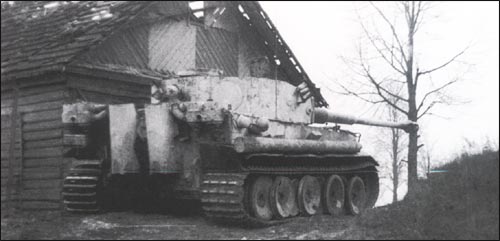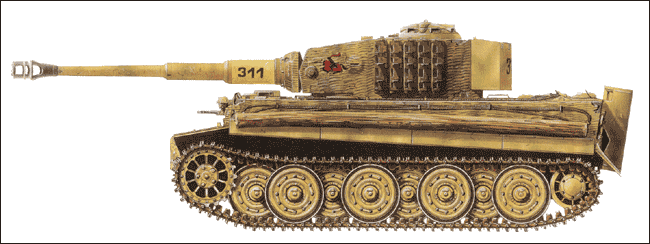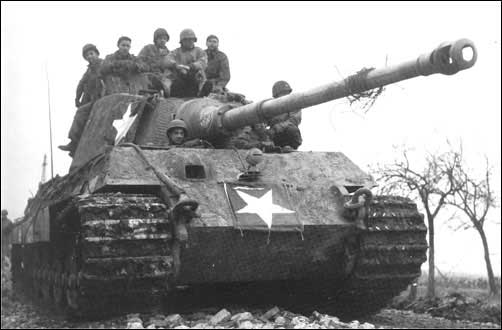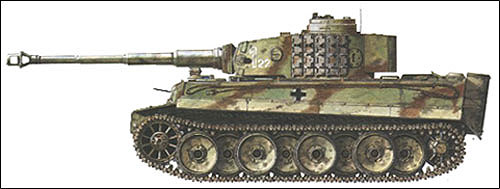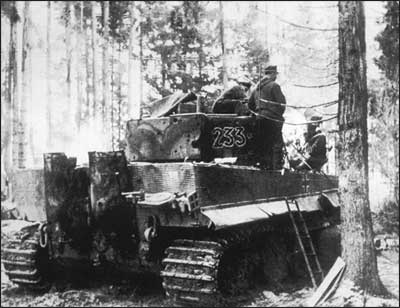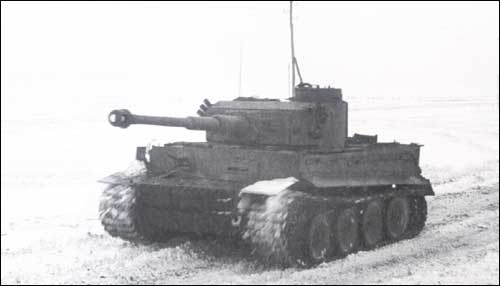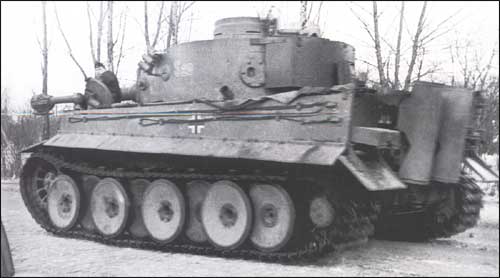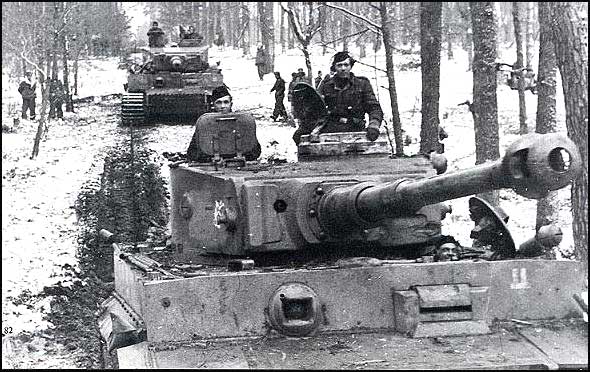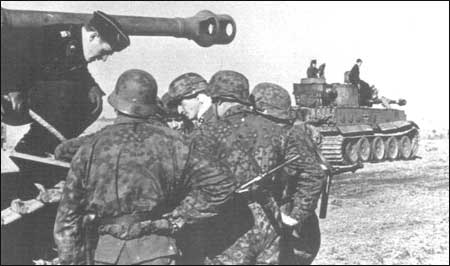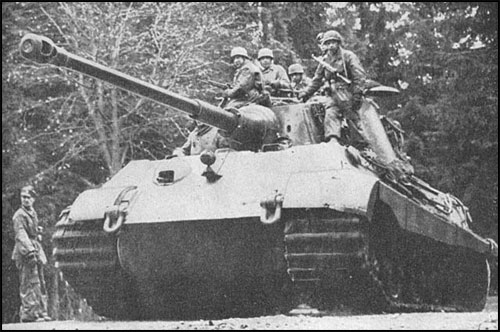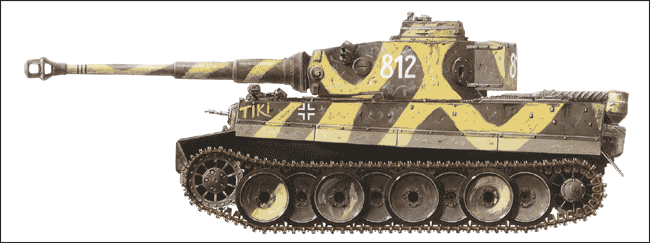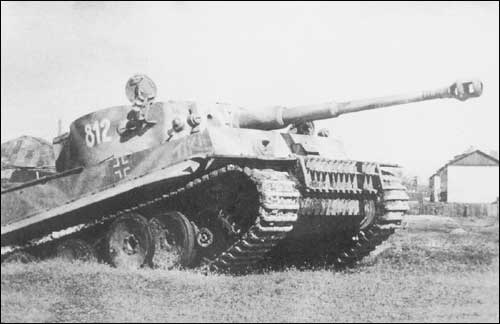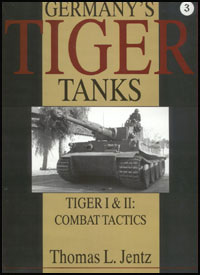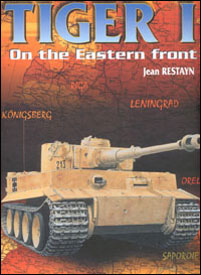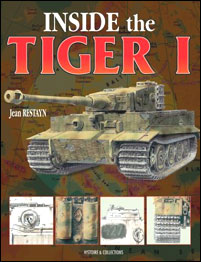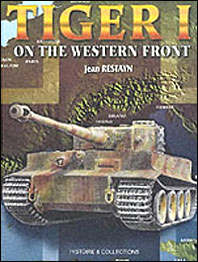|
|
|---|
Schwere Panzer Abteilung 503 - sPzAbt 503 The second unit promised to Rommel,
the 503rd, was to receive Porsche-Tigers, but the cancellation
of production resulted in the 503rd being outfitted with
20 Panzerkampfwagen Tiger Ausf.E and 25 Pz.Kpfw.III Ausf.N in November and December
1942, and first saw action in southern Russia, during the Don campaign
and the withdrawal from Stalingrad.
The 503rd was rested and outfitted with 45 new Tigers and re-entered combat on 25 January 1944. It received a further 35 new Tigers in February and March 1944, before being withdrawn form combat in late April 1944. Transferred back to the West, the 503rd received a further 33 Tiger Is and 12 Tiger IIs and was sent to Normandy. The battalion staff and 1st company had been re-equipped with the new Pz.Kpfw.Tiger Ausf.B, but the 2nd and 3rd companies retained the Tiger I E. The 3rd company was caught in a bombing attack in July 1944, and all of its Tigers were destroyed or damaged. On 9 September 1944, sPzAbt 503 was completely equipped with 45 new Panzerkampfwagen Tiger Ausf.B (Tiger II).
It was then transferred to Hungary and committed to the defense of Budapest. By an order dated December 21, 1944, sPzAbt 503 was renamed sPzAbt Feldherrnhalle and attached to PzGren. Div. FHH. Schwere Panzer Abteilung 504 - sPzAbt 504
The 504th was the second Tiger unit to be sent to Tunisia. It was issued 25 PzKpfw III plus two Panzerbefehlswagen Tiger Ausf.E in January, and 18 Tigers, comprising the battalion staff, workshop company, and 1st tank company arrived in Tunisia on 12 March 1943. The 2nd company remained in Sicily. The tank company had four platoons, each with two Tiger I tanks and two Pzkpw III support tanks. All of the sPzAbt 504 Tigers were destroyed or captured. The surviving elements surrendered on 12 May 1943. On 13 April 1943, the OKH ordered that six Tigers were to be stationed on Sicily and that until transferred to Tunisia, the 2.Kompanie/ schwere Panzer Abteilung 504 was to be attached to PzAbt 215 with a reinforced platoon of six Tigers being immediately shipped to Sicily. Altogether 17 Tigers gathered on Sicily: the original nine from 2.Kompanie of the 504th, two Tigers that had been used as replacements for the 501st in February, and the six Tigers issued in April 1943 for the 215th.
Attached to Panzer Division Herrmann Goering, the 17 Tigers under the 2.Kompanie of the 504th attacked the American landing zone on 11 July 1943, but were neutralized by naval gunfire. Within the first three days ten out of the 17 Tigers were destroyed to prevent capture and a further six Tigers were destroyed later for the same reason. The last Tiger was shipped back across the straits of Messina to Italy. sPzAbt 504 spent the rest of the war in Italy. The battalion was rebuilt with a full three company organization, with additional personnel from PzAbt. 18. The unit trained in Germany, and then returned to Italy. Its first action in Italy was in support of the 362nd Inf. Div. in the containment of the Allied advance up the Italian coast following the Anzio landing. sPzAbt 504 saw a great deal of action in the Italian campaign, including the Arno river campaign and the defense of northern Italy. On 14 August 1944, sPzAbt 504 personnel were sent to the Vienna area, for familiarization training with the Tiger II Ausf B. The battalion was never issued Tiger II, but on 12 February 1945 it received 15 Tiger I from sPzAbt 508. On 15 March 1945, sPzAbt. 504 had 32 Tigers operational, but between 15 - 28 April 1945, 19 Tigers were lost during the retreats around Argenta, Italy. The remaining Tigers were destroyed, mostly by their crews, to avoid the capture of the Tigers by the enemy. The battalion surrendered at the end of the war, along with other German units in Italy. Schwere Panzer Abteilung 505 - sPzAbt 505
The 505th was the last independent battalion created with the old organization of 20 Tigers and 25 Pz.Kpfw.III. Formed in February 1943, the 505th received several Tigers and the rest in March with 25 Pzkpfw IIIs. The unit was loaded on rail cars on 29/30 April 1943 and sent to Heeres Gruppe Mitte on the Eastern Front, where it was ordered to upgrade to the new organization, and received 11 Tigers that were shipped from the ordnance depot between 8 and 10 June 1943. It took part in OPERATION CITADEL as part of Feldmarschall Model's 9th Armee. At the start of the Kursk offensive on 5 July 1943, the unit had 31 Tigers and was joined on 9 July 1943 by 3.Kompanie which was formed in April and received Tigers in June. The 505th lost only four Tigers during the Kursk offensive but lost a further six by the end of July 1943.
After the Kursk offensive, sPzAbt 505 was moved to the Smolensk area. During the fall of 1944, sPzAbt 505 was equipped with new version Tiger Is, which had cast cupolas, zimmerit, and the new steel-rimmed wheels developed for the Panzerkampfwagen Tiger Ausf.B. The 505th was ordered out of the Eastern Front on 7 July 1944, to rest and refit at the troop grounds at Ohrduf. By early September, 1944, sPzAbt 505 had been equipped with new Panzerkampfwagen Tiger Ausf.B. sPzAbt 505 was used with 24th and 25th Panzer Divisions, initially against the Narev bridgeheads in the 1944 Russian offensive into East Prussia. The battalion fought in East Prussia until the end of the conflict.
Schwere Panzer Abteilung 506 - sPzAbt 506 The 506th was formed in July 1943, primarily from personnel of III Abt./Pz. Rgt. 33 of 9th. Pz. Div.. In August, the battalion received forty-five new Tiger I tanks. The unit was engaged in the Dnieper battles in 1943. On New Year's Day, 1944, sPzAbt 506 went to the area south of Korovograd, and fought in Krivoi-Rog. In 1944, sPzAbt 506 was withdrawn to Germany for refitting and preparation for action in the West. Their Tiger Is were distributed as replacement vehicles to other units. sPzAbt 506 received the new Panzerkampfwagen Tiger Ausf.B in August 1944. The full battalion establishment of 45 tanks was retained. In late September, the battalion was sent to the area around Oosterbeck, west of Arnhem. It took part in the German defense against the combined Allied thrust to the Rhine during OPERATION MARKET GARDEN.
The following month, sPzAbt 506 Took
part in the defense of Aachen. In November 1944, the battalion was
strengthened by the addition of a 4th company. This new
company had been organized originally as a heavy assault support
unit, used wherever necessary - a Feuerwehr (fire brigade). Its
first commander was named Hummel, and this was the name given to
the company. sPzKp. "Hummel" (now 4th company,
sPzAbt 506) was equipped with Tiger Is. This new company was fully
integrated by early December 1944. Schwere Panzer Abteilung 507 - sPzAbt 507 The 507th was formed on 23 September 1943, from personnel taken from I Abt./Pz.Rgt. 4 of 13th Pz. Div.. It was organized in the usual fashion: a battalion HQ staff company, 3 tank companies, and a workshop company, plus supply and support detachments, and equipped with 45 Tigers between 23 December 1943 and 25 February 1943. Transferred to the Eastern Front in March 1944, the 507th received seven replacement Tigers before the end of the month and a further 12 in April, eight in July, six in August, ten in November and one final tiger in December 1944. Overstrenght at 55, the 507th met the Russian winter offensive on the Tarnapol river above Vitebk and around Narev, on 14 January 1945, and by 1 February 1945 had only seven tigers left, none of which operational. 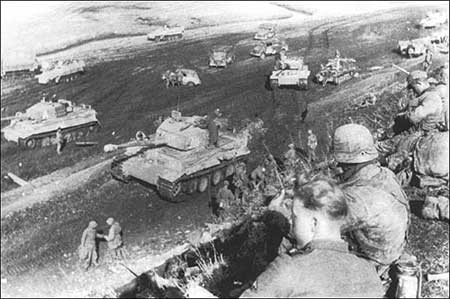 Tigers of sPzAbt.507 in an assembly area preparing for an attack on Tarnopol in April 1944. On 6 February 1945, the 507th was ordered to return to Senneläger, to refit with the Tiger II. The unit received 21 Panzerkampfwagen Tiger Ausf.B: four on 9 March 1945, 11 on 22 March 1945, and the last six on 31 March. The front came to the sPzAbt 507, deployed in the defense of the local area. Schwere Panzer Abteilung 508 - sPzAbt 508
sPzAbt 508 was formed in August of
1943, from personnel from PzRgt. 8, and later, more men from PzAbt
190. Issued with 45 Tigers between December 1943 and January 1944,
the 508th was ordered to Italy to attack the Allied bridgehead
at Anzio. Unloaded at a railhead 200 km from the bridgehead, about
60 per cent of the Tigers suffered mechanical failures negotiating
the narrow, sharply curved mountain roads. Schwere Panzer Abteilung 509 - sPzAbt 509 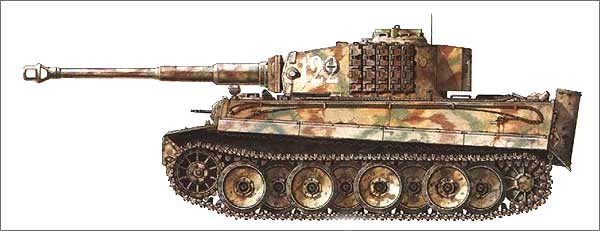 Tiger I, sPzAbt.509, Russia, late 1943. sPzAbt 509 was formed on 9 September 1943, from elements of Pz. Rgt. 204 of 22nd Pz. Div. The battalion was issued 45 Tiger Is, and fought on the Eastern Front. From late 1943 to the early spring of 1944, sPzAbt 509 was engaged near Kirovograd, Kirivoi-Rog, Kiev, and Pavlova, in southern Russia. In November of 1943, the 3rd company of sPzAbt 509 was detached and assigned to support 2 SS Pz. Div. Das Reich. A major reinforcement occurred between 20 May and 1 June 1944, when the unit received 30 Tiger Is. The 1st and 2nd companies fought at Novosselki, Shitomir, Chmelnik, and Kiev. During September of 1944, sPzAbt 509 was in Senneläger, the training ground, for re-equipping with new Panzerkampfwagen Tiger Ausf.B. It was issued 11 Tiger IIs in September that were turned over to the SS 501st.After experiencing further delays in outfitting due to severe interruptions in production at Henschel, the 509th was sent 45 Tiger IIs from the ordnance depot between 5 December 1944 and 1 January 1945. In January of 1945, the battalion was sent to Hungary, and assigned to IV SS PzKorps. It arrived on 15 January 1945, just in time to take part in the third offensive toward Budapest. The German offensive started on January 18th, and this attack is a rare example of an entire, fully-equipped heavy tank battalion, operating under its own commander, and attacking to accomplish the mission for which it was doctrinally intended. In other operations, elements of other battalions were used to create breakthroughs, but were only deployed piecemeal, with separate companies being attached to different divisions. Still, other battalions were employed in a breakthrough role, but were not at, or usually anywhere near, their authorized combat strength of 45 Tigers. It must have been an impressive sight as 45 King Tigers started the mission (WILBECK, Christopher W., op cit). The battalion successfully penetrated the first echelons of the Soviet defenses during this day's operations. There was no intact bridge capable of holding the Pz.Kpfw.Tiger Ausf.B, however, so the German attack continued without sPzAbt.509 for the next few days. During the attack on 18 January 1945, the battalion lost seven King Tigers and destroyed at least 20 Soviet tanks and numerous other antitank guns. After that, the battalion was engaged in a number of battles in Hungary, supporting the third German offensive toward Budapest and then went to Austria. sPzAbt 509 surrendered to American troops on May 9, 1945, near Linz. The battalion had no tanks - its motorized component was one Schwimmwagen, one radio car, and one truck. Schwere Panzer Abteilung 510 - sPzAbt 510
sPzAbt 510 was formed in June, 1944, and was the last of the ten independent heavy tank battalions. It received 45 Tiger Is between 20 June and 7 July 1944, and, from August 1944, fought against the Russians in East Prussia. On 3 August, six replacements were shipped to the 510th. Part of the battalion was detached to 14th Pz. Div. , for an assault on the Russian forces in November 1944. The other company was attached to the 30th Inf. Div. sPzAbt 510 was heavily engaged during the Kurland campaign, operating with 14th Pz. Div., in early 1945. In March, two companies of the battalion were withdrawn to the Kassel area in Germany. The remainder of sPzAbt 510, with 13 Tiger Is, was assigned to 14th Pz Div. The last Tiger was lost on 8 May, and the battalion surrendered with other survivors of the fierce Kurland fighting. The 510th have never been issued a single Tiger II. Schwere Panzer Abteilung (Funklenk) 301 - sPzAbt (FKL) 301 Panzer Abteilung 301 returned from the Eastern Front to rest and refit with Tigers to use as control vehicles for the BIV Sprengladungsträger and was organized with a headquarters and three companies each with 10 Tigers. A total of 21 more Tigers were shipped from the ordnance depot between 25 August and 15 September 1944 and an additional ten were taken over from the s.SS.PzAbt.103. The 301st was first reported on the Western Front by the LXXXI Armee Korps on November 1944 as having 31 Tigers (27 operational) and 66 BIV (61 operational). Four Tigers were lost before the 301st was engaged in the Ardennes Offensive and at the beginning of the attack on 16 December 1944, the 301st reported 27 Tigers available of which 12 were operational. It still had 27 Tigers of which 21 were operational on the Western Front on 30 December 1944. The 301st remained on the Western Front until the end of the War. Schwere Panzer Abteilung (Funklenk) 316 - sPzKp (FKL) 316 sPzKp (FKL) 316 was issued 10 Tiger Is in September 1943 and five Tiger IIs in March 1944, which they did not use in combat. Attached to Panzer Lehr Division and engaged in Normandy, the 316th had six out of eight Tigers undergoing repair on 1 July 1944. By 1 August 1944, the 316th was no longer with the Panzer Lehr Division. 13.Kompanie/Panzer Regiment Großdeutschland
A schwere Kompanie was formed for Panzer Regiment Großdeutschland on 13 January 1943 and received a total of nine Tiger I and ten Pz.Kpfw.III. The company was sent to the Eastern Front in February 1943 and in May received six additional Tigers to upgrade it to the new organization. On 1 July 1943 the unit was renamed as the 9.Kompanie/Panzer Regiment Großdeutschland and at the start of the Kursk offensive on 5 July, the company had 14 out of 15 Tigers operational. None of those were lost during the battle.
III.Abteilung/Panzer Regiment Großdeutschland
An entire heavy tank battalion of three companies with 45 Tigers was created for Panzer Grenadier Division Großdeutschland as the III.Abteilung/Panzer Regiment Großdeutschland. Its first company (9.Kompanie) was provided by the old 13.Kompanie, the second and third companies (10 and 11 Kompanien) were the former 3.Kompanie/sPzAbt.501; and 3.Kompanie/sPzAbt.504 respectively. The Stab, 10 and 11 Kompanien joined the 9.Kompanie at the front on 14 August 1943 by which time they had received 31 Tigers.  Großdeutschalnd schwere Panzer Abteilung marking. The first six replacements arrived at the front on 26 August. Further replacements followed in 1944 with 10 in February, six in March, six in April, 14 in May, 6 in June, 12 in July, 6 in October, and a final 4 in December. The battalion remained on the Eastern Front without being relieved or refitted until the final surrender. The Großdeutschland Tiger unit, from its beginnings as the 13.Kompanie/Panzer Regiment Großdeutschland, through its expansion to battalion status and to its eventual destruction in March 1945, had the highest number of confirmed enemy kills for any Heer Tiger unit, a total of 1,036 tanks and armored fighting vehicles, and over 300 enemy guns. Schwere Panzer Kompanie Hummel The Allied drive out of Normandy decimated the units trapped in the 'Falaise Gap' and the remnants trying to cross the Seine river. With open space all the way to Berlin, the schwere Panzer Kompanie Einzats Dunkirchen was hastily formed by the schwere Panzer Erzats und Ausbildungs Abteilung 500 at the training grounds near Paderborn. This unit with 14 Tigers was sent west on 19 September to stop the British spearhead at Arnhem in Holland. It was renamed the next day, sPzKp Hummel and continued to fight on the Western Front after it was incorporated into sPzAbt.506 as the 4.Kompanie on 8.December 1944. Training and research/development units had originally received a total of 49 Tiger Is for training and 10 Tiger Is for testing. As Germany's position continued to deteriorate, additional units were thrown together and given these worn out tigers in a last ditch effort. Amongst these units were: sPzKp.Paderborn with 15 Tigers on 21 October 1944; Panzer Kompanie Panther with three Tigers (30 January 1945), Erzats Brigade Großdeutschland with two Tigers (31 January 1945), and PzAbt.500 Paderborn with 17 Tigers (both Is and IIs - 2 April 1945). Panzer Abteilung Kummersdorf Having received the last five Tiger Is to be issued on 23 February 1945, this unit joined the makeshift Panzer Division Muncheberg in an attempt to halt the Russian advance. Absorbing remnants from other units it reported having 13 Tigers of which ten were operational on 15 April 1945. Tigergruppe Meyer Before the loss of Sicily, eight
Tigers were shipped from the ordnance depot on 28 July 1943, to
outfit an independent unit destined for Italy. Known as Tigergruppe
Meyer, this small unit with its eight Tigers was attached to PzJgAbt.46
between August and November 1943, and by 4 February 1944 was renamed
Tigergruppe Schwebbach and attached to the LXXVI Panzer Korps to
attack the bridgehead created by the Allied landing at Anzio. Jagdtiger Abteilung 512 Jagdtiger Abteilung 512 was formed in the late fall of 1944 and was equipped with twenty Jagdtiger heavy tank destroyers, mounting 128mm KwK 44 L/55 guns on modified Tiger II Ausf B chassis. 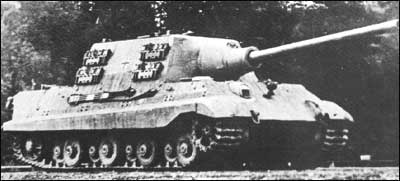 The Jagdtiger. There were two companies, each with 10 vehicles. Two Jagdtigers were in each company HQ section, and four Jagdtigers were in in each of the two platoons. The two companies, named "Company Carius" and "Company Ernst", fought as separate units. "Company Ernst" was reinforced with a platoon of Stug III, one PzKpfw IV, and a platoon of self-propelled 37mm flak guns. Both components fought in Germany's last battles, and surrendered to US forces in the Ruhr. |
Schwere SS Panzer Kompanien (SS-PzRgt.1, 2, and 3)
Effective on 15 November 1942, three schwere Panzer Kompanien were established, one each for SS-Panzer Regiments 1, 2 and 3. Each Kompanie was to have nine Tigers and ten Pz.Kpfw.III. A total of 28 Tigers and 30 Pz.Kpfw.III were issued in December 1942 and January 1943. Sent to the Eastern Front, all three companies took part in the Manstein's counter offensive to retake Kharkov in February March 1943 in which they lost five Tigers. An order dated 22 April 1943 authorized these three companies to be upgraded to 14 Tigers and by this same order the three companies became an organic part of the schwere Panzer Abteilung of the I.SS-Panzer Korps. However, the three companies remained with their Regiments at the front. In May 1943, 17 Tigers were shipped to the front bringing the total to 13 with the 13.sKp/SS-PzRgt.1, 14 with the sKp/SS-PzRgt.2, and 15 with the 9.Kp/SS-PzRgt.3.
Of these 42 Tigers, 35 were operational at the start of the Kursk offensive on 5 July 1943 of which three were lost, one from each company. Five replacements arrived for the 13.Kompanie/SS-Panzer Regiment 1 on 25 July 1943, before it was ordered to Italy with Panzer grenadier Division LSSAH. Before leaving on 28 July 1943, nine Tigers were transferred to.sKp/SS-PzRgt.2 and eight Tigers to 9.Kp/SS-PzRgt.3 The s.Kp/SS-PzRgt.2 remained on the Eastern Front, receiving five tigers in September 1943 and a further five in January 1944. Having lost their last Tiger, the unit was ordered to return to the West on 14 April 1944. 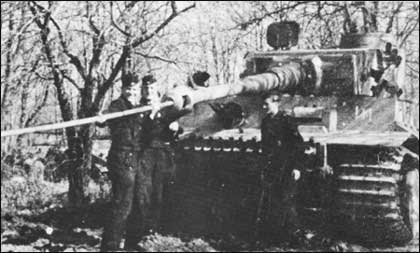 The crew of this Tiger I, of sKp/SS-PzRgt.2, is cleaning the 88 mm KwK 36 L/56 barrel. The 9.Kp/SS-PzRgt.3 also remained in the East Front and received five replacement Tigers on 20 September 1943. Originally ordered to return to the West to refit as part of the parent schwere SS-Panzer Abteilung 101, the order was rescinded by Hitler and 9.Kompanie was then refitted with ten Tigers in May 1944. The final five replacement Tigers were shipped from the ordnance depot on 26 July 1944.
Schwere SS-Panzer Abteilung 101 By an order on 19 July 1943, a schwere Panzer Abteilung was formed for I.SS-Panzer Korps. Two new heavy companies were to be created and 13.Kompanie of SS-Panzer Regiment 1 was to be incorporated as the third company.
Having been pulled out of Russia in response to the landings in Sicily in July 1943, Panzer Grenadier Division Leibstandarte SS Adolf Hitler (LSSAH) was refitted and sent to Italy in August 1943. Attached to the division were elements of the newly formed schwere SS Panzer Abteilung of the I.SS Panzer Korps with 27 Tigers that had been issued in July 1943. As a result of Italy's defection, LSSAH remained in northern Italy until mid-October. The unit was then transferred back to the Eastern Front where it was renamed schwere SS-Panzer Abteilung 101. The 1. and 2. Kompanien went east with LSSAH but the rest of the battalion remained behind at a training ground. Eleven Tigers were received in February 1944 and on 4 April 1944, the remnants of Panzer Division LSSAH were ordered to return to the West to refit. In the interim, the rest of sSS-PzAbt.101 had received 19 Tigers, shipped between October 1943 and January 1944. After the return of the rest of the battalion from the Eastern Front, a further 26 Tigers were received during April 1944. The leading elements of the 101st reached the front in Normandy on 12 June 1944, six days after the Allied landings. By the end of June, the 101st had lost 15 of its 45 Tigers, and was pulled out in July to refit with the Tiger II. The 101st still had 25 Tigers of which 21 were operational on 7 August 1944, but these were all lost during the retreat in August, the remnants of the 101st being ordered back to the training grounds to rest and refit, in Senneläger, with the Tiger II on September 1944. 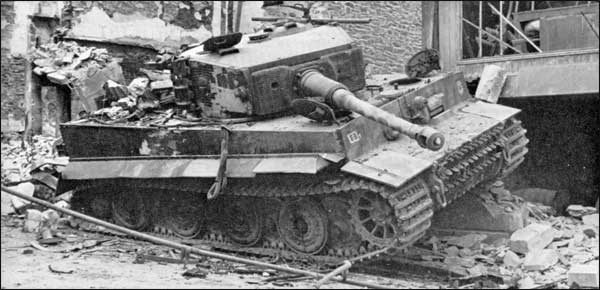 All Tigers of sSS-PzAbt.101 were destroyed in Normandy, 1944. At first it was planned to outfit the battalion with two companies of Tiger Is and one company of Jagdtigers. On 4 November, Hitler ordered that none of the Jagdtigers were to be issued to Tiger battalions. Therefore, the SS 101 was renamed SS 501 Tiger Abteilung and was ordered to outfit the third company with Tiger Is. This order was later rescinded and the third company was also outfitted with Tiger IIs. Due to severe production problems, only six Tiger IIs had been sent to the SS 501st from the ordnance depot on 17 and 18 October. A further eight were shipped in November, for a total of 14 Tiger IIs, enough to outfit one company. Finally 20 more were shipped between 26 November and 3 December. These 34 Tigers IIs were all that were available for issue from the ordnance depot before the SS 501st was loaded on trains and sent to the Western Front on 5 December. To these were added 11 Tiger IIs confiscated from sPzAbt 509 replacement shipping, that was then redirected to the sSS-PzAbt.501. The SS 501st was sent to the Western Front as a key unit for the Ardennes Offensive, unloaded the last of ten trains at Liblau-Euskirchen on 9 December. The SS 501st reported loss of 13 Tiger IIs during fighting in December before a status report revealed a total of 31 Tiger IIs (18 operational). As ordered on 24 January 1945, the SS 501st was transferred to the Eastern Front with the I.SS Panzer Korps. Schwere SS-Panzer Abteilung 102
Originally created in April 1943 as the schwere Panzer Abteilung for the I.SS-Panzer Korps, three Tiger companies were deployed at the front but the headquarters remained behind at he training grounds. On 1 June 1943, the I.SS-Panzer Korps was renamed II.SS-Panzer Korps and the 13.Kp./SS-Pz.Rgt.1 was lost to the sSS-PzAbt. for the new I.SS-Panzer Korps. A new third Tiger kompanie was created and on 22 October 1943, the unit was renamed schwere SS-Panzer Abteilung 102. When the 9.Kompanie/SS-Panzer Regiment 3 was ordered to remain with the 3.SS-Panzer Division 'Totenkopf' in the east, the 120nd was left with two new companies with no experience and the remains of the schwere Kompanie of SS-Panzer Regiment 2 'Das Reich' which returned from the front in April. Six Tigers were shipped from the ordnance depot on 21 April 1944, followed by another 39 between 20 and 29 May 1944.
Ordered to the front in Normandy, the first seven trains unloaded west of Paris on 27 June 1944, however, the threat of attacks from the fighter-bombers was sufficient to delay their arrival at the front until 7 July. On 20 July, the 120nd still had 42 Tigers of which 17 were operational. No fewer than 30 operational Tigers were reported on 30 July and 21 on 8 August 1944 but all these had been lost by 7 September 1944 and the unit was ordered to return to the training grounds to rest and refit with the Tiger II. The s.SS PzAbt.102 (later renamed 502) was ordered on 9 September 1944 to transfer to Senneläger to rest and refit. Due to the shortage, the issue of Tiger IIs was slow in coming. Finally 31 Tiger IIs were shipped from the ordnance depot between 14 February and 6 March 1945. The SS 503rd was transported to the Eastern Front to Heeres Gruppe Mitte starting in mid March, logging their first engagement in combat at Sachsendorf on 22 March. By 27 April 1944 (last report) there were only 5 operational Tiger IIs. Schwere SS-Panzer Abteilung 103
The s.SS-Panzer Abteilung 103 was originally formed on 1 July 1943 as the II.Abt/SS-Pz.Rgt. 11 and sent to Yugoslavia to fight as infantry, however, at the end of November, the battalion was converted to the s SS-PzAbt.103. Issued six Tigers in February for training, the 103rd was ordered to give them to another unit in March 1944. Another six Tiger Is were arrived at the training grounds on 26 May and four more in August. On 20 October, all ten Tigers were given to sPzAbt.(FKL)301 and the 103rd was outfitted with the Tiger II before being ordered to the Eastern Front. The s.SS PzAbt.103, later renamed the 503rd, had a total of 39 (instead of the full complement of 45) Tiger IIs and was loaded on to trains on 27 January 1945, and sent to the Eastern Front in the Heeres Gruppe Weichsel sector. By 15 April 1945 (last report), the 503rd reported a total of 12 Tiger IIs, of which 10 were still operational. Hungary
On 22 July 1944, three Tiger Is left the ordnance depot by rail for delivery to the Hungarian Army. In addition, an unknown number of Tiger Is were acquired from the sPzAbt.503 or the 509th who had been assigned to train the Hungarian crews. Performance of the Tiger Battalions in Action:
|
| Kill/Loss Ratio of the Tiger Battalions (1942 - 1945): | |||
|---|---|---|---|
| Unit | Losses | Kills | Kill/Loss Ratio |
| Schwere Panzer-Abteilung 501 | 120 | 450 | 3.75 |
| Schwere Panzer-Abteilung 502 | 107 | 1,400 | 13.08 |
| Schwere Panzer-Abteilung 503 | 252 | 1,700 | 6.75 |
| Schwere Panzer-Abteilung 504 | 109 | 250 | 2.29 |
| Schwere Panzer-Abteilung 505 | 126 | 900 | 7.14 |
| Schwere Panzer-Abteilung 506 | 179 | 400 | 2.23 |
| Schwere Panzer-Abteilung 507 | 104 | 600 | 5.77 |
| Schwere Panzer-Abteilung 508 | 78 | 100 | 1.28 |
| Schwere Panzer-Abteilung 509 | 120 | 500 | 4.17 |
| Schwere Panzer-Abteilung 510 | 65 | 200 | 3.08 |
| 13./Panzer-Regiment Großdeutschland | 6 | 100 | 16.67 |
| III./Panzer-Regiment Großdeutschland | 98 | 500 | 5.10 |
| 13./SS-Panzer-Regiment 1 | 42 | 400 | 9.52 |
| 8./SS-Panzer-Regiment 2 | 31 | 250 | 8.06 |
| 9./SS-Panzer-Regiment 3 | 56 | 500 | 8.93 |
| Schwere SS-Panzer-Abteilung 101 (501) | 107 | 500 | 4.67 |
| Schwere SS-Panzer-Abteilung 102 (502) | 76 | 600 | 7.89 |
| Schwere SS-Panzer-Abteilung 103 (503) | 39 | 500 | 12.82 |
| TOTAL: | 1,715 | 9,850 | 5.74 |
| Source: Tiger I Information Center web site. | |||
Bibliography
You can find Mr Jean Restayn's
books at J.J.Fedorowicz
Publishing, Inc. and 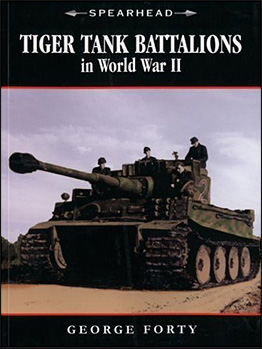 Tiger Tank Battalions in World War II. By George Forty.  Sledgehammers, by Christopher W. Wilbeck.  You can find Mr Jean Restayn's
books at J.J.Fedorowicz
Publishing, Inc. and |
|

